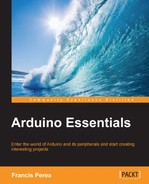The Arduino platform has become a de facto standard when talking about microcontrollers. With a wide range of different board models, it can cover a wide spectrum of projects, and its ease of use has made it the preferred platform for those starting out in the microcontroller world.
If you are a hobbyist wanting to develop projects based on Arduino as its main microcontroller platform or an engineer interested in knowing what the Arduino platform offers, then this book is ideal for you.
If you have little or no previous experience in these kinds of tools, this book will help you get a complete view of the platform and the wide peripherals it has to offer by following a carefully designed set of project examples that cover the most important platform features.
Whether you have never written a line of code or you already know how to program in C, you will learn how to work with Arduino from the point of view of both hardware and software thanks to the easily understandable code that accompanies every project that has been developed exclusively with that premise in mind. This will be easy for those who don't have previous experience in programming.
This book was written with the aim to present the Arduino platform to all those wanting to work with Arduino but without any great knowledge of the microcontrollers scene. It will gradually develop a wide set of projects that have been designed to cover the most important aspects of the Arduino platform, from the use of digital and analog inputs and outputs to harnessing the power of interrupts.
Chapter 1, Meeting the Arduino Family, introduces you to the Arduino platform, and the different board models that integrate the Arduino family are presented, noting their common aspects.
Chapter 2, The Arduino Development Environment, shows you how to download, install, and set up a working Arduino integrated development environment and gives a complete explanation of its use and commands.
Chapter 3, Interacting with the Environment the Digital Way, covers the connection and use of digital outputs by dealing with simple devices that can be digitally operated, such as LEDs.
Chapter 4, Controlling Outputs Softly with Analog Outputs, shows you how to manage analog outputs and the use of transistor drivers to deal with high-current devices, such as motors.
Chapter 5, Sensing the Real World through Digital Inputs, explains the use of digital inputs by giving examples of typical applications, such as buttons and switches, and proposes an optical coin detection device that uses an optocoupler.
Chapter 6, Analog Inputs to Feel between All and Nothing, presents analog inputs and their use and offers two new projects: an ambient light meter with a photocell and a motor speed controller by using a potentiometer as an input device.
Chapter 7, Managing the Time Domain, introduces you to the different tools the Arduino library offers to deal precisely with time by building two more projects: a simple timer and a visual and acoustic metronome.
Chapter 8, Communicating with Others, shows you how to connect your Arduino projects to other platforms via serial communication and how to use the Serial Monitor to read from and send data to Arduino. A computer-controlled motor speed driver and a dial thermometer will be built.
Chapter 9, Dealing with Interrupts, shows you how to use interrupts to deal with unexpected events and to understand the difference between having to wait for something to occur and be called when it occurs. We will use a tachograph as a good example to show you all these concepts.
Chapter 10, Arduino in a Real Case – Greenhouse Control, gives you a complete real example of a project that summarizes all the concepts learned throughout the book.
